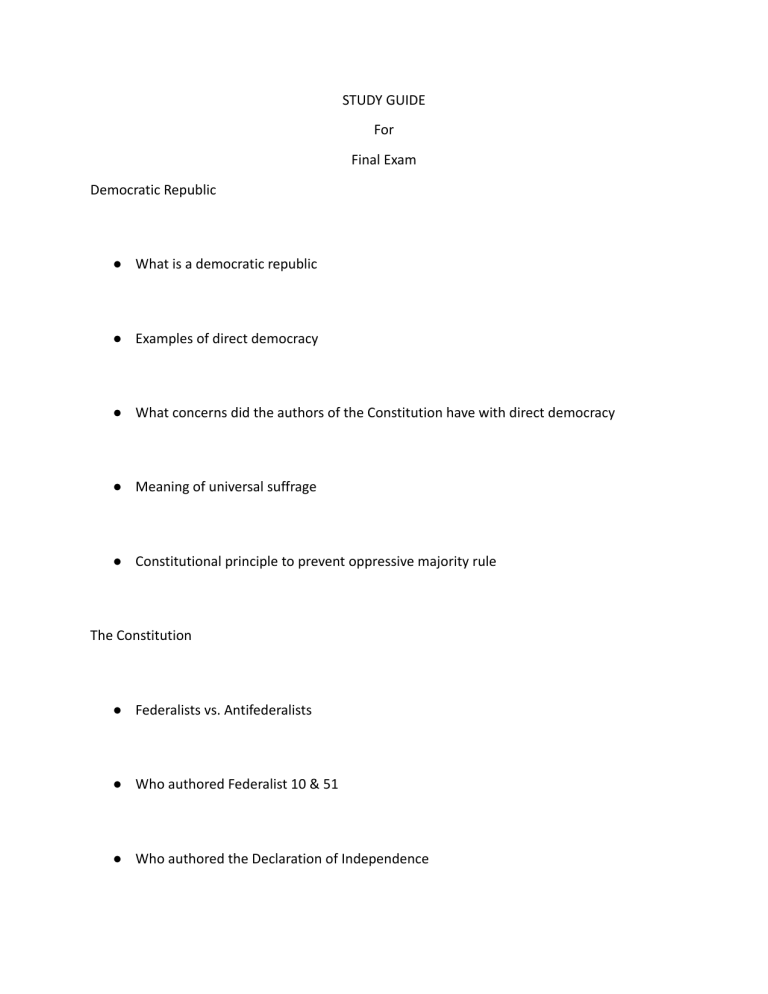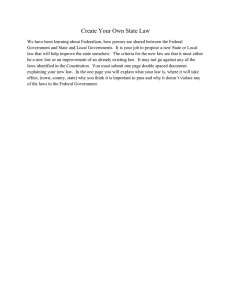
STUDY GUIDE For Final Exam Democratic Republic ● What is a democratic republic ● Examples of direct democracy ● What concerns did the authors of the Constitution have with direct democracy ● Meaning of universal suffrage ● Constitutional principle to prevent oppressive majority rule The Constitution ● Federalists vs. Antifederalists ● Who authored Federalist 10 & 51 ● Who authored the Declaration of Independence ● Purpose of separation of powers & checks and balances ● Judicial review ● Role of Bill of Rights in ratifying the Constitution ● Name of first constitution of the US ● Process of ratifying the Constitution ● Number and meaning of stars and stripes on US flag Federalism and Missouri Government ● Definition of federalism ● Dual vs. Cooperative federalism ● What year was the first constitution of Missouri adopted ● Which constitution provides more democracy – US or MO ● 10th Amendment – what is it about ● Who is the chief elections officer in states/Missouri ● State official with responsibilities like US president ● Supremacy clause Civil Liberties ● Definition ● 1st, 4th,5th, 6th, 8th Amendment ● What do government authorities need to conduct a legal search of someone’s property ● Roe v. Wade – what is it about Civil Rights ● Definition ● 13th, 14th, 15th, and 19th Amendment ● Brown v. Board of Education ● Civil Rights technique advocated by Rev. Martin Luther King Public Opinion, Political Socialization, and the Media ● Ideology that prefers private sector to manage the economy ● Ideology that claims capitalism works best with government regulation/oversight ● Which political part are individuals with high incomes likely to support ● Which political party are people in urban areas likely to support ● What is the primary source of revenue for privately owned media companies Interest Groups and Political Parties ● What electoral system provides a suitable environment for a two-party system ● Political parties vs. interest groups Campaigns and Elections ● What is a primary election ● How the number of electoral college votes for each state is determined ● Number of electoral college votes needed to become president of the US ● Term that describes the process of allocating House seats among states Congress ● Delegates vs. trustees ● Who signs bills into laws ● Most powerful leader in the US Senate ● Most powerful leader in the US House of Representatives ● Term describing unlimited debate in the Senate ● Who does most of the legislative work in Congress The President ● Role or powers of the US president o Chief executive, head of state, etc. ● Amendment that limits the number of terms an individual can serve as US president ● Part of the Constitution that (Article and Section) that defines qualifications to run for president of US ● Line of succession to presidency The Executive Branch ● Pendleton Act ● Privatization ● What are the two categories of federal employees The Courts ● Sources of American law ● How do federal justices and judges get their job ● Opinions of the court – majority, concurring, dissenting, etc ● Judicial activism, judicial restraint, etc. Domestic and Economic Policy ● Problems associated with an economic boom ● Problems associated with an economic recession ● Policies used to stabilize or stimulate the economy ● Meaning and example of a progressive tax ● Meaning and example of a mandatory expenditure ● Term that describes when a government spends more than has Foreign Policy ● Foreign policy philosophies ● Which federal department uses diplomacy as its main tool ● Powers of US president that makes him or her dominant in foreign policy ● Cold War – countries involved, what was it about, where conflicts took place ● US foreign policy in 1800s, 1900s, and 2000s








